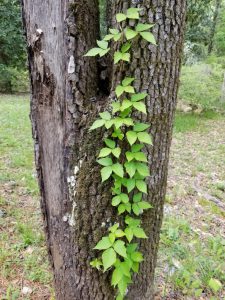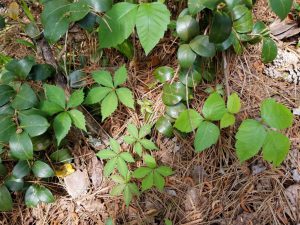Many times over the years homeowners have asked me to come out and identify or confirm whether or not they have poison ivy in their flower beds or on their trees. There are a few plants such as box elder and Virginia creeper that can be mistaken for poison ivy. However, when in doubt, if you think you came in contact with the plant, rinse with cold water as soon as possible.
Last week, I was hiking at Callaway Gardens enjoying what was left of the blooming azaleas when I bent down to take a picture of a trillium when my friend said “watch out for that poison ivy.” I quickly backed away. That was the inspiration for this post. Homeowners often mistake Virginia creeper for poison ivy. Virginia creeper has compound, palmate leaves with five leaflets, but it can sometimes has three to seven leaflets.

Virginia Creeper
Poison ivy, on the other hand, is a woody perennial that can grow as a small shrub or as a high climbing vines with aerial rootlets on trees, fence rows or fence posts. The leaves are alternately arranged on the stem. Each compound leaf consists of three bright green, shiny leaflets that are elliptic to egg-shaped and have smooth, toothed or lobed margins. The top of the leaf is smooth, while hair is found on the vein of the underside of the leaf.

Poison Ivy
The leaf shape and texture of poison ivy may vary on the same plant or plants near each other. Therefore, one can mistake a plant to be something other than poison ivy, even though it may, in fact, be poison ivy. So as the old saying goes, “Leaflets three, let it be” should be strongly followed.
So, if you have correctly identified poison ivy growing in your flower bed or climbing up a tree,
there are some cultural and chemical control measures that can be taken. Cultural control measures include repeated tillage, cutting or mowing it at or near ground level throughout the year will eventually control it. This may take years to achieve, however. Digging the plant and roots out of small beds is another measure. But no matter how you handle it, always handle poison ivy or its roots with water proof gloves.
Many times I see poison ivy growing up trees and chemical control might be warranted. Your first instinct may be to just yank it out. Resist the urge to do that. Instead cut the vine about 2 to 3 feet above the soil line. This will kill the plant portion above the cut. Immediately treat the cut portion by painting it with a 41% solution of glyphosate concentrate. Mix 6 to 12 oz. of glyphosate solution to a gallon of water. Repeat application with a 5% or 10% solution. Glyphosate requires a one-hour rain-free period for maximum activity. Be careful not to get glyphosate on desirable plants. So don’t treat on windy days.
So even if you come across Virginia creeper or poison ivy try to avoid contact with your skin and select a control measure that fits your situation. For more information or proper identification please contact your local Extension office.

Virginia creeper and poison ivy
Source: Controlling Poison Ivy in the Landscape by Dr. Mark Czarnota, Weed Control Specialist
Photos by James Morgan